University Financial Analysis Project Report: Telstra Valuation
VerifiedAdded on 2023/03/30
|8
|1085
|454
Report
AI Summary
This report presents a financial analysis of Telstra, focusing on its valuation using two primary models: the Free Cash Flow Method (FCFM) and the Dividend Discount Model (DDM). The analysis begins with an introduction to valuation and its significance in determining a company's worth. It then calculates the cost of capital, including the cost of equity and cost of debt, and determines the Weighted Average Cost of Capital (WACC). The report then applies the FCFM and DDM to estimate the intrinsic value of Telstra's shares, comparing these values with the market price to identify potential investment opportunities. The diagnosis section compares the intrinsic value to the market price and provides investment recommendations. The report concludes with a summary of findings, suggesting a long-term investment in Telstra due to its undervalued stock price. References and an appendix with supporting calculations are included.
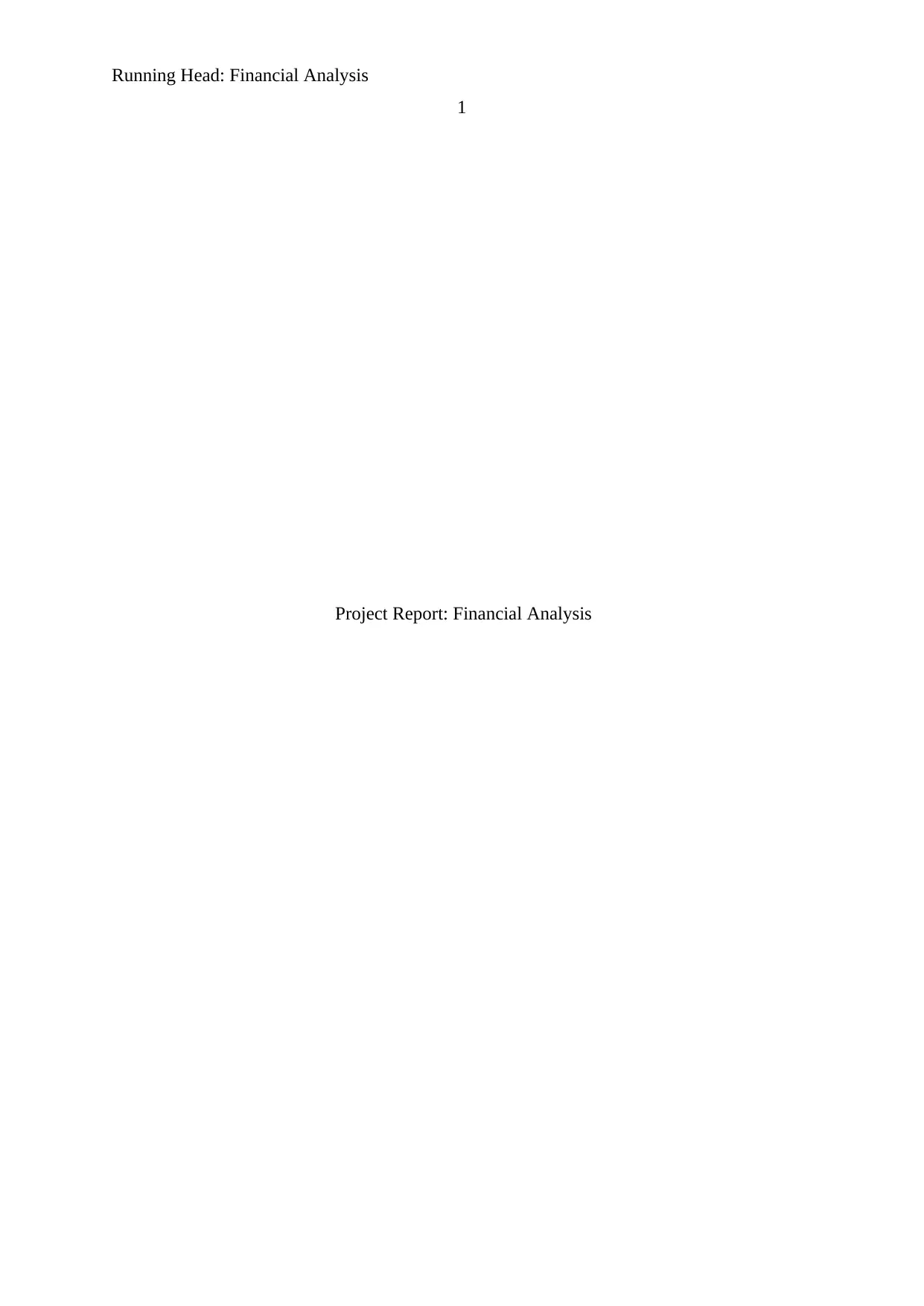
Running Head: Financial Analysis
1
Project Report: Financial Analysis
1
Project Report: Financial Analysis
Paraphrase This Document
Need a fresh take? Get an instant paraphrase of this document with our AI Paraphraser
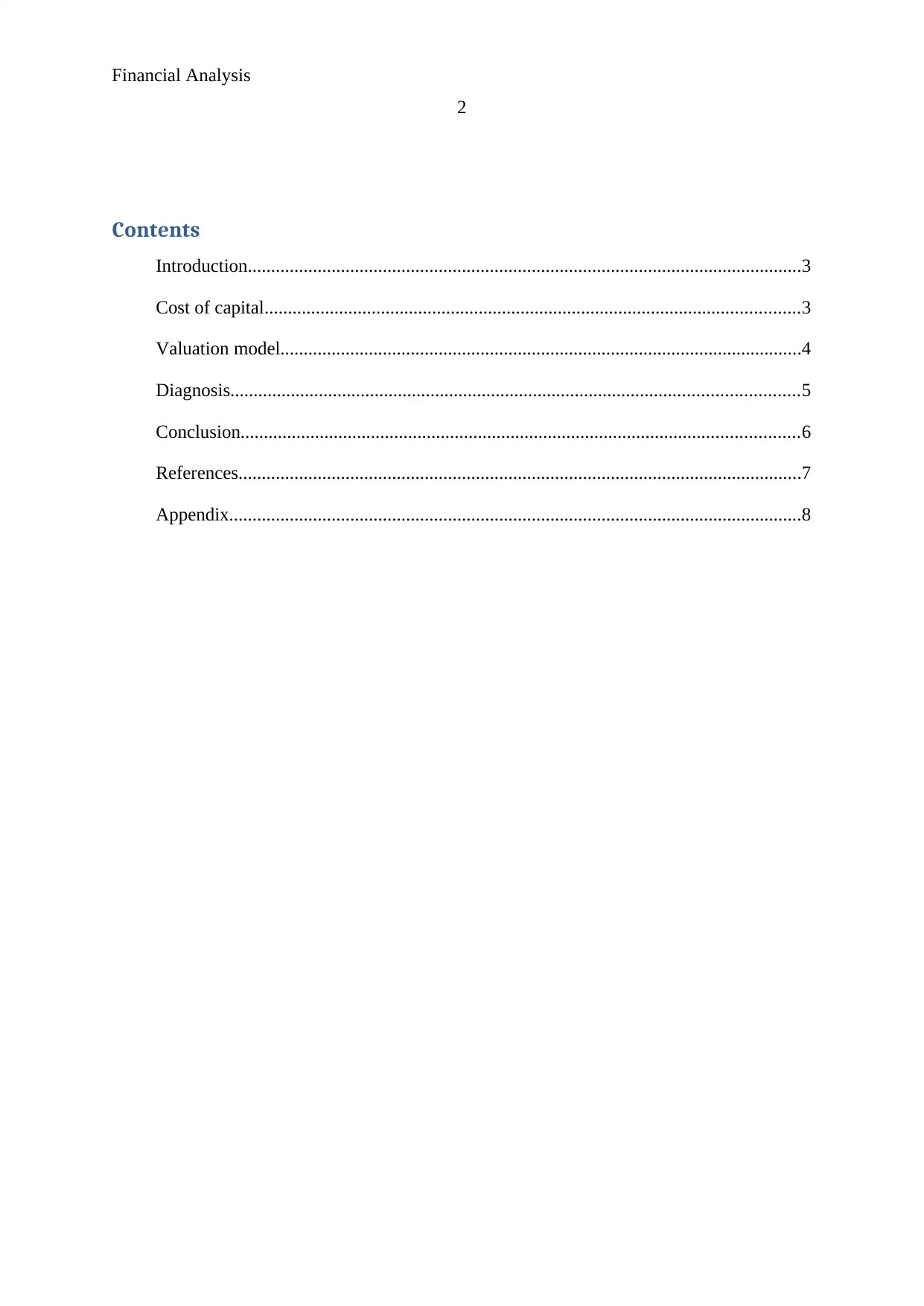
Financial Analysis
2
Contents
Introduction.......................................................................................................................3
Cost of capital...................................................................................................................3
Valuation model................................................................................................................4
Diagnosis..........................................................................................................................5
Conclusion........................................................................................................................6
References.........................................................................................................................7
Appendix...........................................................................................................................8
2
Contents
Introduction.......................................................................................................................3
Cost of capital...................................................................................................................3
Valuation model................................................................................................................4
Diagnosis..........................................................................................................................5
Conclusion........................................................................................................................6
References.........................................................................................................................7
Appendix...........................................................................................................................8
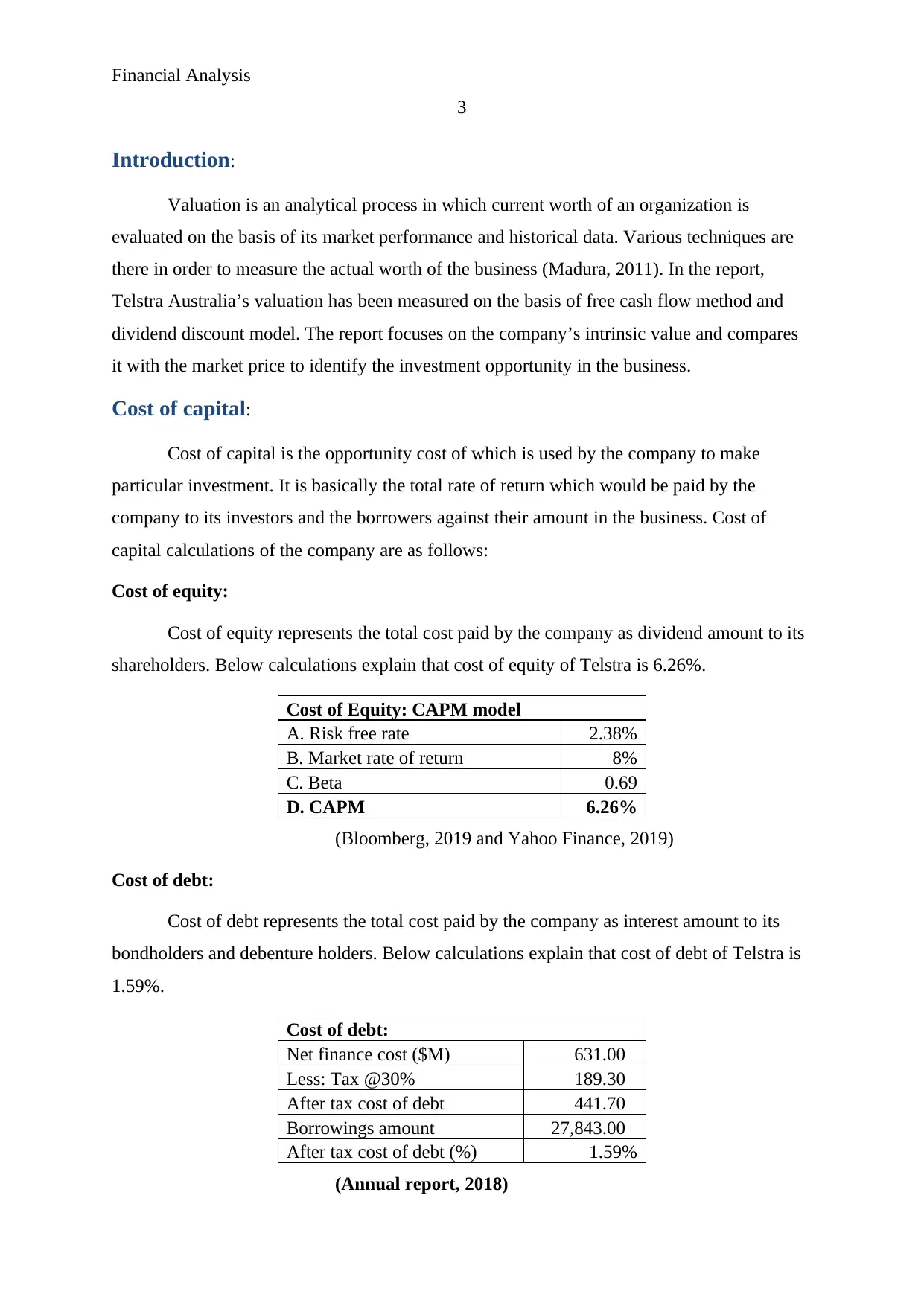
Financial Analysis
3
Introduction:
Valuation is an analytical process in which current worth of an organization is
evaluated on the basis of its market performance and historical data. Various techniques are
there in order to measure the actual worth of the business (Madura, 2011). In the report,
Telstra Australia’s valuation has been measured on the basis of free cash flow method and
dividend discount model. The report focuses on the company’s intrinsic value and compares
it with the market price to identify the investment opportunity in the business.
Cost of capital:
Cost of capital is the opportunity cost of which is used by the company to make
particular investment. It is basically the total rate of return which would be paid by the
company to its investors and the borrowers against their amount in the business. Cost of
capital calculations of the company are as follows:
Cost of equity:
Cost of equity represents the total cost paid by the company as dividend amount to its
shareholders. Below calculations explain that cost of equity of Telstra is 6.26%.
Cost of Equity: CAPM model
A. Risk free rate 2.38%
B. Market rate of return 8%
C. Beta 0.69
D. CAPM 6.26%
(Bloomberg, 2019 and Yahoo Finance, 2019)
Cost of debt:
Cost of debt represents the total cost paid by the company as interest amount to its
bondholders and debenture holders. Below calculations explain that cost of debt of Telstra is
1.59%.
Cost of debt:
Net finance cost ($M) 631.00
Less: Tax @30% 189.30
After tax cost of debt 441.70
Borrowings amount 27,843.00
After tax cost of debt (%) 1.59%
(Annual report, 2018)
3
Introduction:
Valuation is an analytical process in which current worth of an organization is
evaluated on the basis of its market performance and historical data. Various techniques are
there in order to measure the actual worth of the business (Madura, 2011). In the report,
Telstra Australia’s valuation has been measured on the basis of free cash flow method and
dividend discount model. The report focuses on the company’s intrinsic value and compares
it with the market price to identify the investment opportunity in the business.
Cost of capital:
Cost of capital is the opportunity cost of which is used by the company to make
particular investment. It is basically the total rate of return which would be paid by the
company to its investors and the borrowers against their amount in the business. Cost of
capital calculations of the company are as follows:
Cost of equity:
Cost of equity represents the total cost paid by the company as dividend amount to its
shareholders. Below calculations explain that cost of equity of Telstra is 6.26%.
Cost of Equity: CAPM model
A. Risk free rate 2.38%
B. Market rate of return 8%
C. Beta 0.69
D. CAPM 6.26%
(Bloomberg, 2019 and Yahoo Finance, 2019)
Cost of debt:
Cost of debt represents the total cost paid by the company as interest amount to its
bondholders and debenture holders. Below calculations explain that cost of debt of Telstra is
1.59%.
Cost of debt:
Net finance cost ($M) 631.00
Less: Tax @30% 189.30
After tax cost of debt 441.70
Borrowings amount 27,843.00
After tax cost of debt (%) 1.59%
(Annual report, 2018)
⊘ This is a preview!⊘
Do you want full access?
Subscribe today to unlock all pages.

Trusted by 1+ million students worldwide
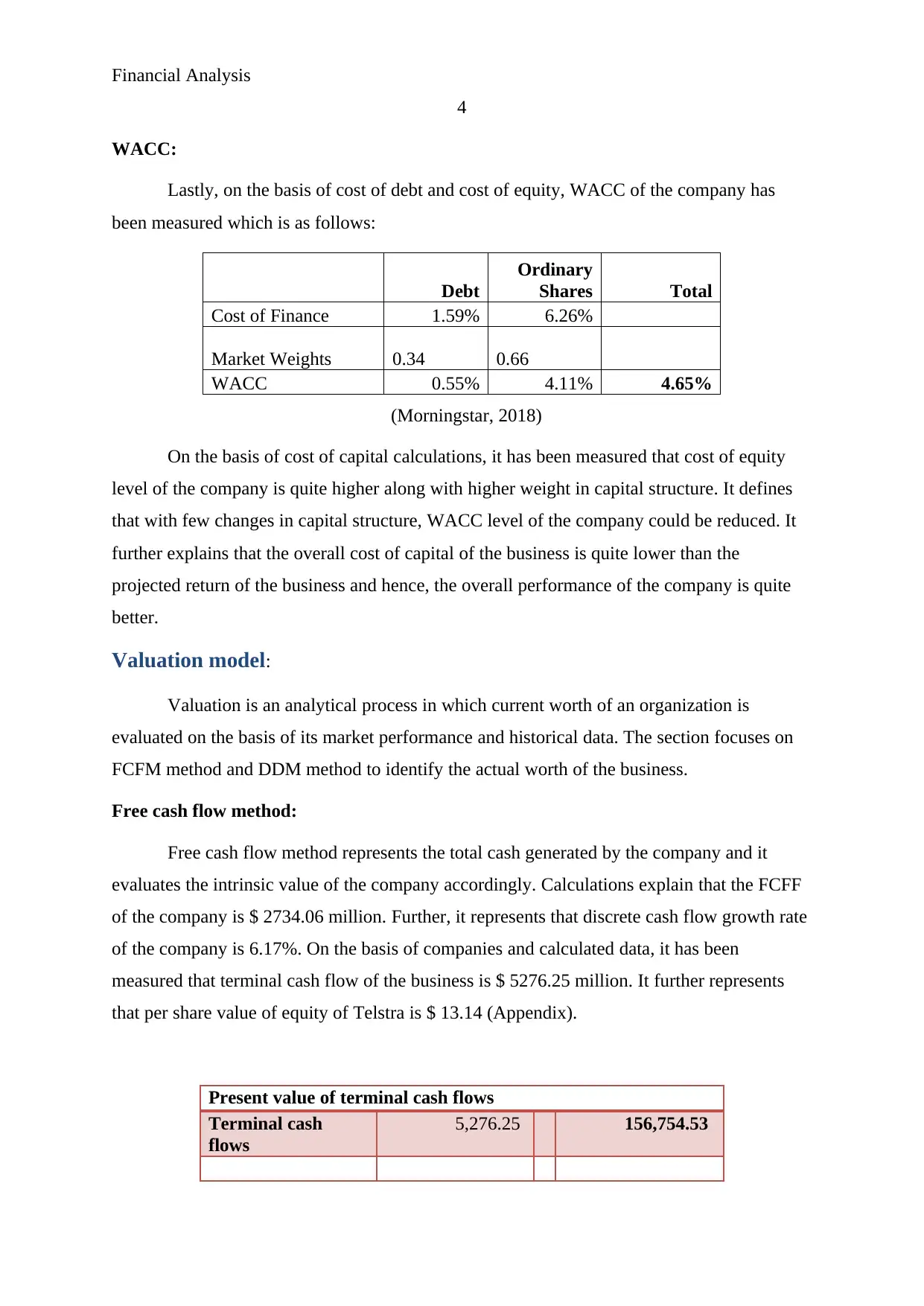
Financial Analysis
4
WACC:
Lastly, on the basis of cost of debt and cost of equity, WACC of the company has
been measured which is as follows:
Debt
Ordinary
Shares Total
Cost of Finance 1.59% 6.26%
Market Weights 0.34 0.66
WACC 0.55% 4.11% 4.65%
(Morningstar, 2018)
On the basis of cost of capital calculations, it has been measured that cost of equity
level of the company is quite higher along with higher weight in capital structure. It defines
that with few changes in capital structure, WACC level of the company could be reduced. It
further explains that the overall cost of capital of the business is quite lower than the
projected return of the business and hence, the overall performance of the company is quite
better.
Valuation model:
Valuation is an analytical process in which current worth of an organization is
evaluated on the basis of its market performance and historical data. The section focuses on
FCFM method and DDM method to identify the actual worth of the business.
Free cash flow method:
Free cash flow method represents the total cash generated by the company and it
evaluates the intrinsic value of the company accordingly. Calculations explain that the FCFF
of the company is $ 2734.06 million. Further, it represents that discrete cash flow growth rate
of the company is 6.17%. On the basis of companies and calculated data, it has been
measured that terminal cash flow of the business is $ 5276.25 million. It further represents
that per share value of equity of Telstra is $ 13.14 (Appendix).
Present value of terminal cash flows
Terminal cash
flows
5,276.25 156,754.53
4
WACC:
Lastly, on the basis of cost of debt and cost of equity, WACC of the company has
been measured which is as follows:
Debt
Ordinary
Shares Total
Cost of Finance 1.59% 6.26%
Market Weights 0.34 0.66
WACC 0.55% 4.11% 4.65%
(Morningstar, 2018)
On the basis of cost of capital calculations, it has been measured that cost of equity
level of the company is quite higher along with higher weight in capital structure. It defines
that with few changes in capital structure, WACC level of the company could be reduced. It
further explains that the overall cost of capital of the business is quite lower than the
projected return of the business and hence, the overall performance of the company is quite
better.
Valuation model:
Valuation is an analytical process in which current worth of an organization is
evaluated on the basis of its market performance and historical data. The section focuses on
FCFM method and DDM method to identify the actual worth of the business.
Free cash flow method:
Free cash flow method represents the total cash generated by the company and it
evaluates the intrinsic value of the company accordingly. Calculations explain that the FCFF
of the company is $ 2734.06 million. Further, it represents that discrete cash flow growth rate
of the company is 6.17%. On the basis of companies and calculated data, it has been
measured that terminal cash flow of the business is $ 5276.25 million. It further represents
that per share value of equity of Telstra is $ 13.14 (Appendix).
Present value of terminal cash flows
Terminal cash
flows
5,276.25 156,754.53
Paraphrase This Document
Need a fresh take? Get an instant paraphrase of this document with our AI Paraphraser

Financial Analysis
5
Total value of Firm ($M) 183,962.36
Less: Value of Debt 27,843.00
Total value of Equity 156,119.36
No of Shares Outstanding 11,877.00
Per share value of value of equity 13.14
(Annual report, 2018)
FCFF model is applied by the investors in case of long term investment and at the
time of consistent return from the stock of the business
Dividend discount model:
DDM valuation model bases upon the theory that an organization’s stock price is the
sum of future dividend paid by the company. It evaluates the dividend growth rate and future
dividend of the business to measure stock price. Calculations represent that dividend growth
rate of the company is 6.09% and the intrinsic value of the company is $ 28.06 (Appendix).
Dividend Discount Model
Dividend expected 0.40
Growth rate 6.09%
Discount rate 4.65%
Intrinsic Value 28.06
(Yahoo finance, 2019)
DDM model is applied by the investors in case of short term investment and at the
time of consistent return from the stock of the business.
Diagnosis:
On the basis of valuation process of the company, it has been measured that the
terminal cash flow from FCFF model is $ 5276.25 million. It further explains that total value
of firm is $ 183,962.36 million. It finally concludes that the intrinsic value of the company
per share is $ 13.14 whereas the market worth of stock of the company is $ 3.57 (Appendix).
It explains that the stock worth of the company is undervalued in the market and hence, it is
the right time for the investors to buy the stock of the company to get higher risk with less
associated risk.
More to it, DDM model explains that the intrinsic value of the company per share is $
28.06 whereas the market worth of stock of the company is $ 3.57. It explains that the stock
5
Total value of Firm ($M) 183,962.36
Less: Value of Debt 27,843.00
Total value of Equity 156,119.36
No of Shares Outstanding 11,877.00
Per share value of value of equity 13.14
(Annual report, 2018)
FCFF model is applied by the investors in case of long term investment and at the
time of consistent return from the stock of the business
Dividend discount model:
DDM valuation model bases upon the theory that an organization’s stock price is the
sum of future dividend paid by the company. It evaluates the dividend growth rate and future
dividend of the business to measure stock price. Calculations represent that dividend growth
rate of the company is 6.09% and the intrinsic value of the company is $ 28.06 (Appendix).
Dividend Discount Model
Dividend expected 0.40
Growth rate 6.09%
Discount rate 4.65%
Intrinsic Value 28.06
(Yahoo finance, 2019)
DDM model is applied by the investors in case of short term investment and at the
time of consistent return from the stock of the business.
Diagnosis:
On the basis of valuation process of the company, it has been measured that the
terminal cash flow from FCFF model is $ 5276.25 million. It further explains that total value
of firm is $ 183,962.36 million. It finally concludes that the intrinsic value of the company
per share is $ 13.14 whereas the market worth of stock of the company is $ 3.57 (Appendix).
It explains that the stock worth of the company is undervalued in the market and hence, it is
the right time for the investors to buy the stock of the company to get higher risk with less
associated risk.
More to it, DDM model explains that the intrinsic value of the company per share is $
28.06 whereas the market worth of stock of the company is $ 3.57. It explains that the stock

Financial Analysis
6
worth of the company is undervalued in the market and hence, it is the right time for the
investors to buy the stock of the company to get higher risk with less associated risk
(Brigham & Houston, 2012).
The risk associated with the stock of the company is also lesser than the market risk
and competitor risk. Along with that, cost of capital of the company is also lower. It
concludes that the investment into the business would be beneficial for the investors.
Conclusion:
On the basis of overall study, it is recommended to the investors of the company to
make an investment for the long term in the company. Currently, the stock price of the
company is undervalued in the market and hence, the current investment would offer great
return to the investors of the company.
6
worth of the company is undervalued in the market and hence, it is the right time for the
investors to buy the stock of the company to get higher risk with less associated risk
(Brigham & Houston, 2012).
The risk associated with the stock of the company is also lesser than the market risk
and competitor risk. Along with that, cost of capital of the company is also lower. It
concludes that the investment into the business would be beneficial for the investors.
Conclusion:
On the basis of overall study, it is recommended to the investors of the company to
make an investment for the long term in the company. Currently, the stock price of the
company is undervalued in the market and hence, the current investment would offer great
return to the investors of the company.
⊘ This is a preview!⊘
Do you want full access?
Subscribe today to unlock all pages.

Trusted by 1+ million students worldwide
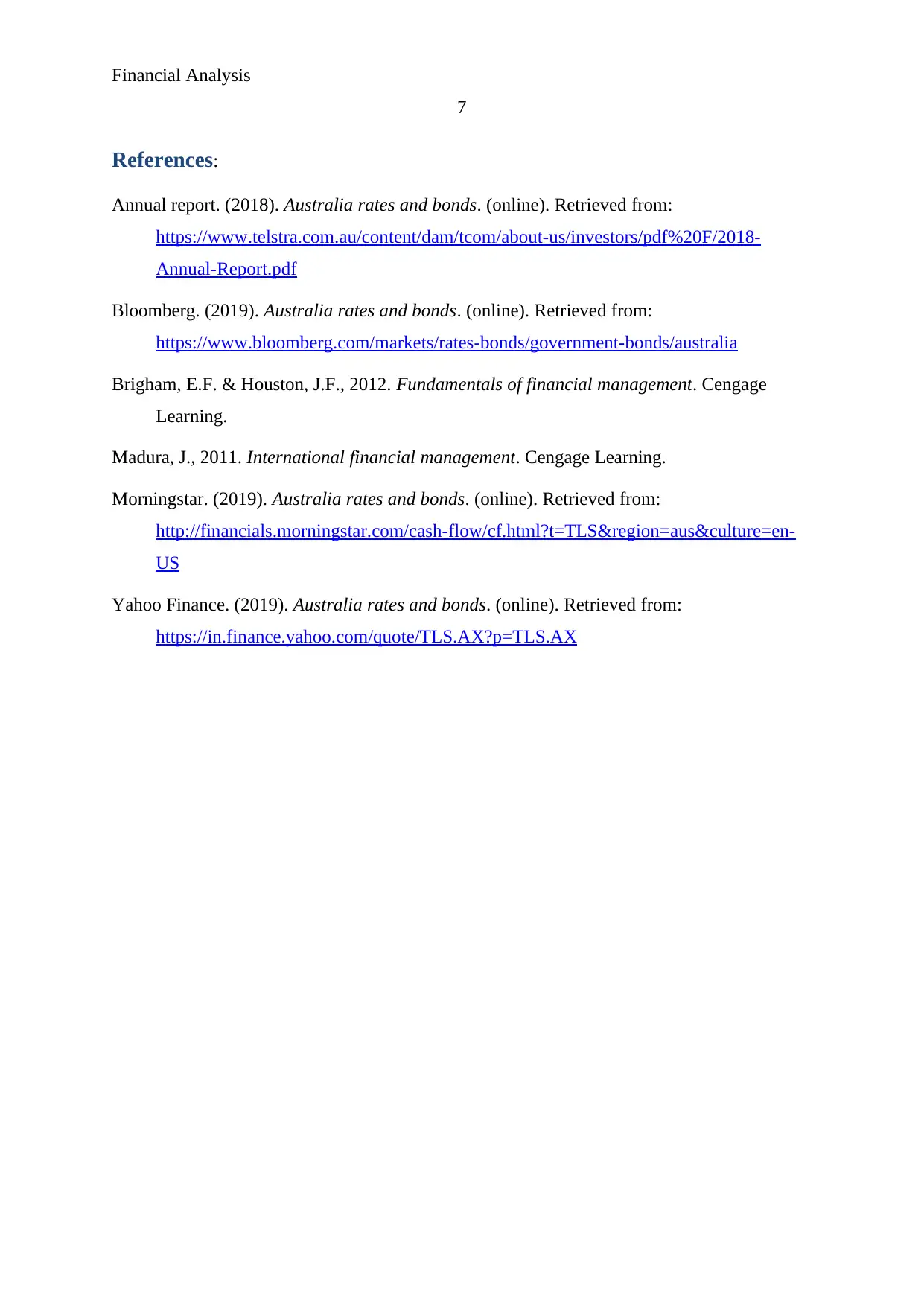
Financial Analysis
7
References:
Annual report. (2018). Australia rates and bonds. (online). Retrieved from:
https://www.telstra.com.au/content/dam/tcom/about-us/investors/pdf%20F/2018-
Annual-Report.pdf
Bloomberg. (2019). Australia rates and bonds. (online). Retrieved from:
https://www.bloomberg.com/markets/rates-bonds/government-bonds/australia
Brigham, E.F. & Houston, J.F., 2012. Fundamentals of financial management. Cengage
Learning.
Madura, J., 2011. International financial management. Cengage Learning.
Morningstar. (2019). Australia rates and bonds. (online). Retrieved from:
http://financials.morningstar.com/cash-flow/cf.html?t=TLS®ion=aus&culture=en-
US
Yahoo Finance. (2019). Australia rates and bonds. (online). Retrieved from:
https://in.finance.yahoo.com/quote/TLS.AX?p=TLS.AX
7
References:
Annual report. (2018). Australia rates and bonds. (online). Retrieved from:
https://www.telstra.com.au/content/dam/tcom/about-us/investors/pdf%20F/2018-
Annual-Report.pdf
Bloomberg. (2019). Australia rates and bonds. (online). Retrieved from:
https://www.bloomberg.com/markets/rates-bonds/government-bonds/australia
Brigham, E.F. & Houston, J.F., 2012. Fundamentals of financial management. Cengage
Learning.
Madura, J., 2011. International financial management. Cengage Learning.
Morningstar. (2019). Australia rates and bonds. (online). Retrieved from:
http://financials.morningstar.com/cash-flow/cf.html?t=TLS®ion=aus&culture=en-
US
Yahoo Finance. (2019). Australia rates and bonds. (online). Retrieved from:
https://in.finance.yahoo.com/quote/TLS.AX?p=TLS.AX
Paraphrase This Document
Need a fresh take? Get an instant paraphrase of this document with our AI Paraphraser

Financial Analysis
8
Appendix:
Refer to attached spreadsheet
8
Appendix:
Refer to attached spreadsheet
1 out of 8
Related Documents
Your All-in-One AI-Powered Toolkit for Academic Success.
+13062052269
info@desklib.com
Available 24*7 on WhatsApp / Email
![[object Object]](/_next/static/media/star-bottom.7253800d.svg)
Unlock your academic potential
Copyright © 2020–2025 A2Z Services. All Rights Reserved. Developed and managed by ZUCOL.





